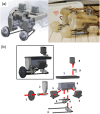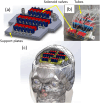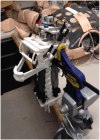Integrated Design and Prototyping of a Robotic Head for Ocular and Craniofacial Trauma Simulators
- PMID: 39744974
- PMCID: PMC11694338
- DOI: 10.1002/rcs.70039
Integrated Design and Prototyping of a Robotic Head for Ocular and Craniofacial Trauma Simulators
Abstract
Background: Medical simulation is relevant for training medical personnel in the delivery of medical and trauma care, with benefits including quantitative evaluation and increased patient safety through reduced need to train on patients.
Methods: This paper presents a prototype medical simulator focusing on ocular and craniofacial trauma (OCF), for training in management of facial and upper airway injuries. It consists of a physical, electromechanical representation of head and neck structures, including the mandible, maxillary region, neck, orbit and peri-orbital regions to replicate different craniofacial traumas. Actuation and hydraulic systems are designed to control animatronic features and flow of simulated blood, tears, and cerebrospinal fluid.
Results: Experimentally validated, the OCF simulator achieves structural and functional characteristics as close as possible to those of a human body.
Conclusions: The OCF Simulator can be used as a stand-alone active simulator, it can be transported and used to train surgeons in simulated real-life scenarios.
Clinical trial registration: The authors declare that this statement is not applicable since no clinical tests have been performed.
Keywords: craniofacial trauma; medical simulators; physician training; robotic human head.
© 2025 The Author(s). The International Journal of Medical Robotics and Computer Assisted Surgery published by John Wiley & Sons Ltd.
Conflict of interest statement
The authors declare no conflicts of interest.
Figures






















Similar articles
-
A comparative analysis and guide to virtual reality robotic surgical simulators.Int J Med Robot. 2018 Feb;14(1). doi: 10.1002/rcs.1874. Epub 2017 Nov 10. Int J Med Robot. 2018. PMID: 29125206
-
Coincidence of craniocerebral and craniofacial injuries.J Craniomaxillofac Surg. 2019 Feb;47(2):287-292. doi: 10.1016/j.jcms.2018.11.024. Epub 2018 Dec 3. J Craniomaxillofac Surg. 2019. PMID: 30581084
-
A Comparison of Robotic Simulation Performance on Basic Virtual Reality Skills: Simulator Subjective Versus Objective Assessment Tools.J Minim Invasive Gynecol. 2017 Nov-Dec;24(7):1184-1189. doi: 10.1016/j.jmig.2017.07.019. Epub 2017 Jul 27. J Minim Invasive Gynecol. 2017. PMID: 28757439 Clinical Trial.
-
Robotic Surgery: The Impact of Simulation and Other Innovative Platforms on Performance and Training.J Minim Invasive Gynecol. 2021 Mar;28(3):490-495. doi: 10.1016/j.jmig.2020.12.001. Epub 2020 Dec 10. J Minim Invasive Gynecol. 2021. PMID: 33310145 Review.
-
Robotic surgery training with commercially available simulation systems in 2011: a current review and practice pattern survey from the society of urologic robotic surgeons.J Endourol. 2012 Mar;26(3):283-93. doi: 10.1089/end.2011.0371. Epub 2012 Jan 12. J Endourol. 2012. PMID: 22192114 Review.
References
-
- Wade A. L., Dye J. L., Mohrle C. R., and Galarneau M. R., “Head, Face, and Neck Injuries During Operation Iraqi Freedom Ii: Results From the us Navy‐Marine Corps Combat Trauma Registry,” Journal of Trauma and Acute Care Surgery 63, no. 4 (2007): 836–840, 10.1097/01.ta.0000251453.54663.66. - DOI - PubMed
MeSH terms
Grants and funding
LinkOut - more resources
Full Text Sources
Medical

